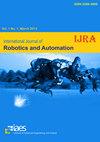军用光通信系统
IF 1
4区 计算机科学
Q4 AUTOMATION & CONTROL SYSTEMS
International Journal of Robotics & Automation
Pub Date : 2019-04-08
DOI:10.15406/iratj.2019.05.00177
引用次数: 0
摘要
本文研究了利用光链路的卫星间通信系统,其最终目标是在印制板上构建光接收器。光学接收器用块图表示。根据各部件的优缺点进行了选型,并对各部件进行了说明和分析。考虑到每个块可以执行的不同选项,被选择为最合适和对接收者将拥有的整套组件最有利的选项。在这篇文章中,介绍和解释了每个阶段的收件人,以及它的组成部分。为了补充,在每个块上实际执行测试,有时主要组件特定于同一块。最后得出结论:低频光学接收机的建模和制备,能够满足所提出的所有目标,可以将该解决方案等同于能够在空间轨道卫星上工作的接收机。本文章由计算机程序翻译,如有差异,请以英文原文为准。
Optical communication system for military applications
This article deals with the study of intercommunication systems used by satellites that use optical link and its ultimate goal is the construction of an optical receiver in a printed board. The optical receiver was represented by a diagram of blocks. The choice of components was made based on the advantages and disadvantages which have, each one being explained and analyzed. Taking into account the different options that can be carried out for each block, was chosen as the most suitable and beneficial to the entire set of components that the recipient will have. Throughout this article was made an introduction and explanation of each stage of the recipient, as well as of its components. To complement, tests were performed practical on each block, and sometimes the main component in specific to that same block. It is concluded that the modeling and preparation of optical receiver for low frequency, is able to meet all the objectives set forth, may equate this solution to a receiver capable of operating in a satellite in orbit of space.
求助全文
通过发布文献求助,成功后即可免费获取论文全文。
去求助
来源期刊
CiteScore
1.20
自引率
44.40%
发文量
71
审稿时长
8 months
期刊介绍:
First published in 1986, the International Journal of Robotics and Automation was one of the inaugural publications in the field of robotics. This journal covers contemporary developments in theory, design, and applications focused on all areas of robotics and automation systems, including new methods of machine learning, pattern recognition, biologically inspired evolutionary algorithms, fuzzy and neural networks in robotics and automation systems, computer vision, autonomous robots, human-robot interaction, microrobotics, medical robotics, mobile robots, biomechantronic systems, autonomous design of robotic systems, sensors, communication, and signal processing.

 求助内容:
求助内容: 应助结果提醒方式:
应助结果提醒方式:


